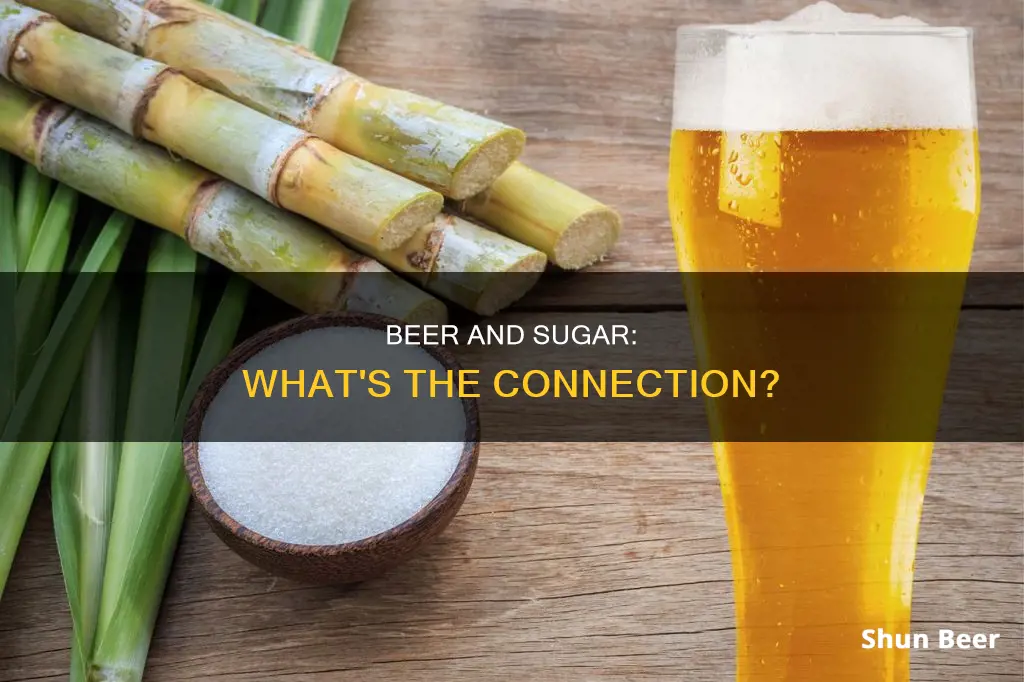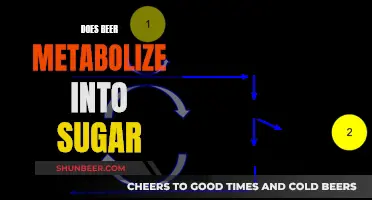
Beer is a popular alcoholic beverage, often enjoyed as a casual drink or to unwind after a long day. But does beer contain sugar? The short answer is yes, beer does contain sugar, but the amount varies depending on the type and brand of beer. The sugar in beer is created during the fermentation process, where yeast converts fermentable sugars from malted grains into alcohol and carbon dioxide. While most sugars are converted, some residual sugars remain, contributing to the beer's taste and body.
The amount of sugar in beer depends on several factors, including the brewing process, the type of yeast used, and the ingredients. Different styles of beer, such as ales, lagers, and stouts, have distinct sugar profiles due to variations in yeast activity, brewing temperatures, and ingredients. Regular beers typically contain more sugar than light beers, as the latter are crafted to be lower in calories and carbs. Non-alcoholic beers, on the other hand, often have higher sugar levels since the sugars are not converted into alcohol during fermentation.
While beer contains sugar, it is important to note that it is not added as an ingredient but is a byproduct of the fermentation process. The main ingredients in beer are typically water, grains (such as barley or wheat), hops, and yeast. The brewing process involves malting, mashing, boiling, fermenting, and maturation, all of which impact the final sugar content in the beer.
In summary, beer does contain sugar, but the amount varies and it is not directly added as an ingredient. Understanding the brewing process and the different types of beer can help provide insight into the sugar content of your favourite brew.
What You'll Learn
- Beer contains very little sugar, but it does have carbs, which can raise your blood sugar
- Sugar in beer comes from the grains used in the brewing process, not from direct addition
- Beer's sugar content varies depending on the type and brand of beer
- Beer gravity is a measurement of the sugar content in beer, with high-gravity beers having more residual sugars
- Beer is lower in sugar than other alcoholic drinks like wine and cocktails

Beer contains very little sugar, but it does have carbs, which can raise your blood sugar
Beer is made from grains (often barley or wheat), hops, yeast, and water. While sugar is not usually added as an ingredient, it is necessary to produce alcohol. The sugar in beer comes from the processing of the grains. During the malting process, grains are soaked, germinated, and dried to convert stored starches into fermentable sugars. The malted grains are then soaked in hot water to release these sugars, creating a sugar-containing liquid called wort.
During the fermentation process, yeast is added to the wort to convert the sugars into alcohol and carbon dioxide. While most sugars are converted, some residual sugar remains, contributing to the beer's taste and body. The amount of residual sugar depends on the type of yeast and the fermentation process. Ale yeast tends to ferment quickly and can digest a variety of sugars, resulting in a drier finish. Lager yeast, on the other hand, ferments more slowly and cleanly, often resulting in a crisper and clearer beer with a slightly higher sugar content.
Overall, beer contains very little sugar. A 12-ounce serving of regular beer typically has around 12.8 grams of carbohydrates and less than 1 gram of sugar. Light beers have slightly more sugar, with about 5.9 grams of carbs and 0.3 grams of sugar per 12 ounces. Non-alcoholic beers, on the other hand, have the highest sugar content, with about 28.5 grams of carbs and sugar per 12 ounces.
However, it is important to note that beer does contain carbohydrates, which can affect your blood sugar levels. Carbohydrates are sugars, and sugar is the most basic unit of carbs. So, while the sugar content of beer may be low, the carbohydrates in regular beers can still impact your blood sugar. Additionally, beer is a significant source of calories, and alcohol can impair sugar metabolism, leading to potential hypoglycemia or low blood sugar levels. Therefore, it is generally recommended to consume beer with a carb-containing meal.
Cider Beers: Sugar Content and Health Considerations
You may want to see also

Sugar in beer comes from the grains used in the brewing process, not from direct addition
The sugar content in beer is a result of the brewing process. Beer is made from four basic ingredients: water, grains (often barley or wheat), hops, and yeast. The sugar in beer comes from the grains used, not from direct addition.
The first step in the brewing process is malting, where grains are soaked, germinated, and dried to convert stored starches into fermentable sugars. The most common sugar in beer is maltose, which is made up of two glucose molecules. The malted grains are then soaked in hot water to release these sugars, creating a sweet liquid called wort.
During the boiling step, hops are added for flavor and to balance the sweetness with bitterness, and the wort is sterilized. After the wort is cooled, yeast is introduced and ferments the sugars, producing alcohol and carbon dioxide. This transforms the wort into beer.
While most sugars are converted during fermentation, some residual sugar remains, contributing to the beer's taste and body. The amount of residual sugar varies depending on the type of beer, with high gravity beers typically having more residual sugars and stronger flavors.
Different beer styles, such as ales, lagers, and stouts, exhibit distinct sugar profiles due to variations in yeast activity, brewing temperatures, and ingredients used. Understanding beer gravity, which measures the density of the wort, is essential in brewing as it influences both the sweetness and alcohol content of the beer.
Best Sugar-Free Beers: Enjoy Guilt-Free Sipping
You may want to see also

Beer's sugar content varies depending on the type and brand of beer
Beer typically contains very little sugar, but the amount varies depending on the type and brand. The sugar content of beer depends on the initial gravity and the type of yeast strain used during fermentation. Beer manufacturers may also add other sugar-containing ingredients, such as honey and corn syrup, to create distinct flavours.
Regular beers usually have a moderate amount of sugar, which is converted into alcohol during the brewing process. Light beers, on the other hand, are crafted to be lower in calories and carbs, resulting in reduced sugar content and a lighter body. Non-alcoholic beers, however, can have higher sugar levels than their alcoholic counterparts since the sugars are not converted into alcohol.
The type of beer also plays a role in its sugar content. For example, pilsners, lagers, and India Pale Ales (IPAs) generally have lower sugar levels, while stouts, porters, and wheat beers tend to have higher sugar content.
Additionally, the yeast strain and fermentation process influence the sugar levels in ales and lagers. Ales, fermented with Saccharomyces cerevisiae, often have a drier finish due to their vigorous fermentation, while lagers, fermented with Saccharomyces pastorianus, tend to have a slightly higher sugar content due to more residual unfermented sugars.
- Bud Light: 1.9 grams
- Coors Light: less than 1 gram
- Miller Lite: 1 gram
- Heineken: 5 grams
- Guinness Draught: 3 grams
- Corona Extra: 2 grams
- Stella Artois: 3 grams
- Samuel Adams Boston Lager: 5 grams
- Sierra Nevada Pale Ale: 3 grams
Sugar Secrets: Priming Beer with Precise Sugar Grams
You may want to see also

Beer gravity is a measurement of the sugar content in beer, with high-gravity beers having more residual sugars
Beer gravity is a measure of the density of the wort (the liquid extracted from the brewing ingredients) before and after fermentation. It is essentially a measure of the sugar content in beer, as the density of the wort is determined by its sugar concentration.
The gravity of the wort before fermentation is called the 'original gravity' (OG) and the gravity of the beer after fermentation is called the 'final gravity' (FG). The difference between the two is used to calculate the alcohol content of the beer.
A high original gravity means that the wort is rich in sugars, which will be converted into alcohol by the yeast during fermentation. This will result in a beer with a high alcohol content. A high final gravity means that the beer still contains a lot of residual sugars, giving it a sweeter taste.
Beer gravity is usually measured using a hydrometer, which floats at different heights depending on the density of the liquid it is placed in. The denser the liquid, the higher the hydrometer will float. Other tools for measuring beer gravity include refractometers and pycnometers.
Beer and Sugar: What's the Connection?
You may want to see also

Beer is lower in sugar than other alcoholic drinks like wine and cocktails
Beer is generally made from grains, spices, yeast, and water. Barley and wheat are the most commonly used grains, while hops are the main flavoring spice. While sugar is not added as an ingredient, it is produced during the germination of the grains and is necessary for the production of alcohol.
The amount of sugar in beer depends on the type of beer and the ingredients used. Most beers contain little sugar, but light beers, such as Miller Lite, tend to have slightly more. Non-alcoholic beers have the highest sugar content as the sugar in the wort is not converted into alcohol.
Beer's sugar content is typically lower than that of other alcoholic drinks. A regular beer has around 12.8 grams of carbohydrates and no sugar, while a light beer has about 5.9 grams of carbohydrates and 0.3 grams of sugar. In comparison, a glass of wine can have up to 8 grams of sugar, and a mixed drink can easily contain over 30 grams of sugar due to the addition of mixers or simple sugars.
Beer has a higher carbohydrate content than wine or liquor, but its sugar content is lower. Regular beer has 12 grams of carbohydrates per serving, while light beer has approximately 6 grams. Wine, on the other hand, has less than 1 gram of sugar per serving for red table wines and 1.5 grams for white table wines. Dessert wines, which have added sugar, can have up to 8 grams of sugar per serving.
So, if you're looking for a drink with a lower sugar content, beer, especially light beer, is a better option than wine or cocktails. However, it's important to remember that beer still contains carbohydrates, which can affect blood sugar levels, and alcohol, which can have negative health effects if consumed in excess.
Sugar's Effect on Beer Carbonation: Does it Fizz or Flop?
You may want to see also
Frequently asked questions
Sugar is required in the beer-making process, but it is not added as an ingredient. Instead, it comes from the germination of the grains.
The amount of sugar in beer varies depending on the type and brand of beer. Generally, beer has less sugar than other alcoholic drinks like wine. However, some beers can have a higher sugar content due to added ingredients, like honey or corn syrup.
During fermentation, yeast converts sugar molecules into alcohol and carbon dioxide. This process determines the final alcohol content of the beer.







